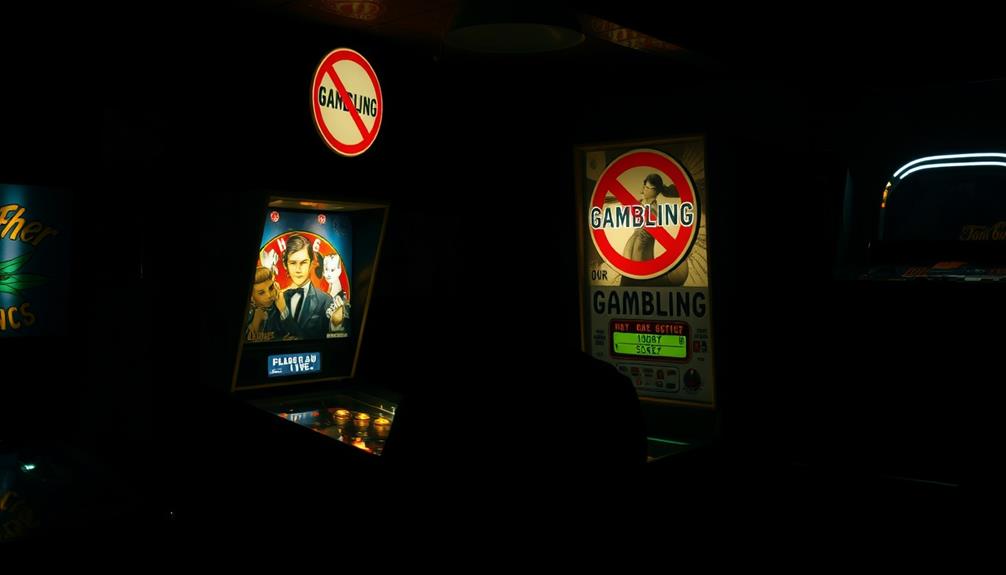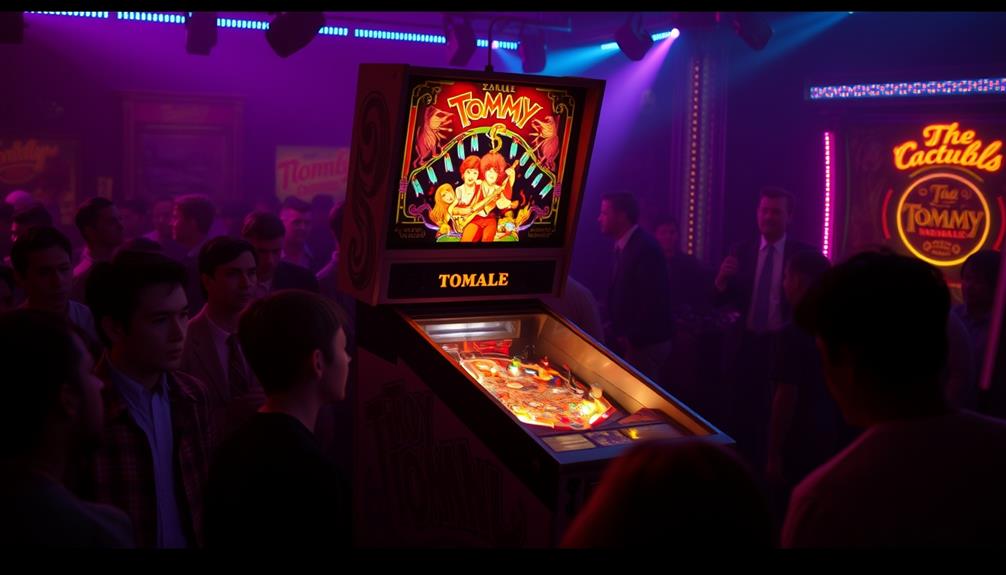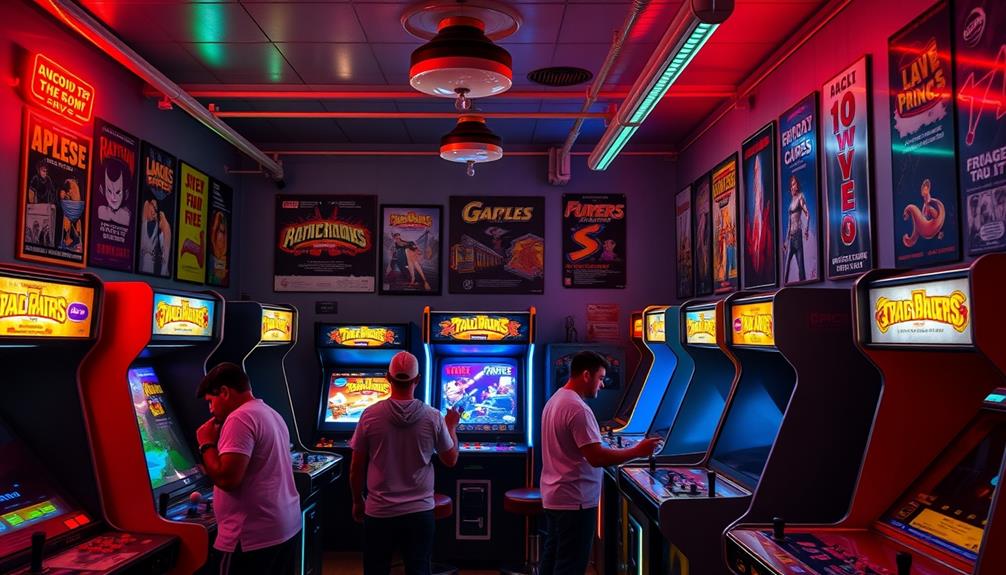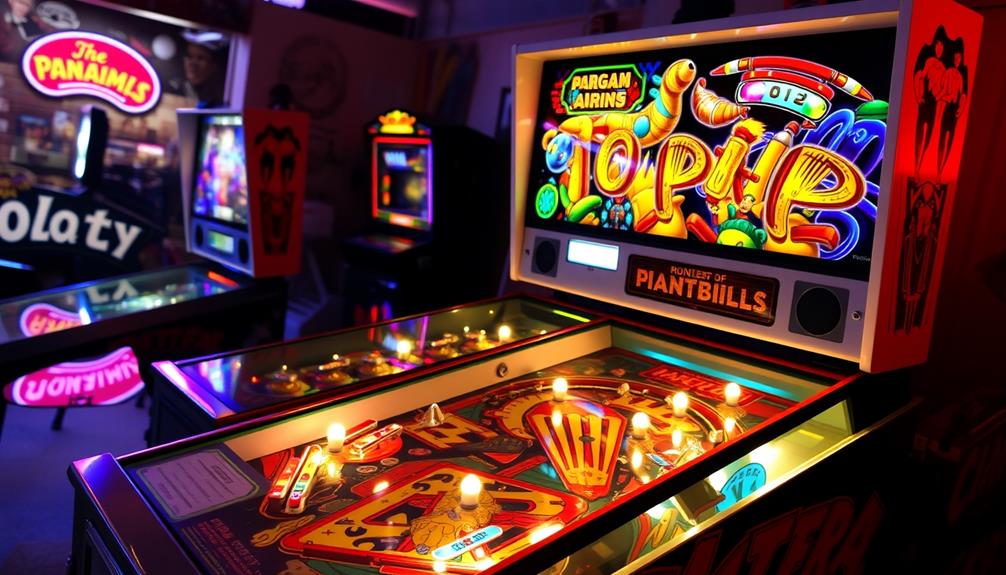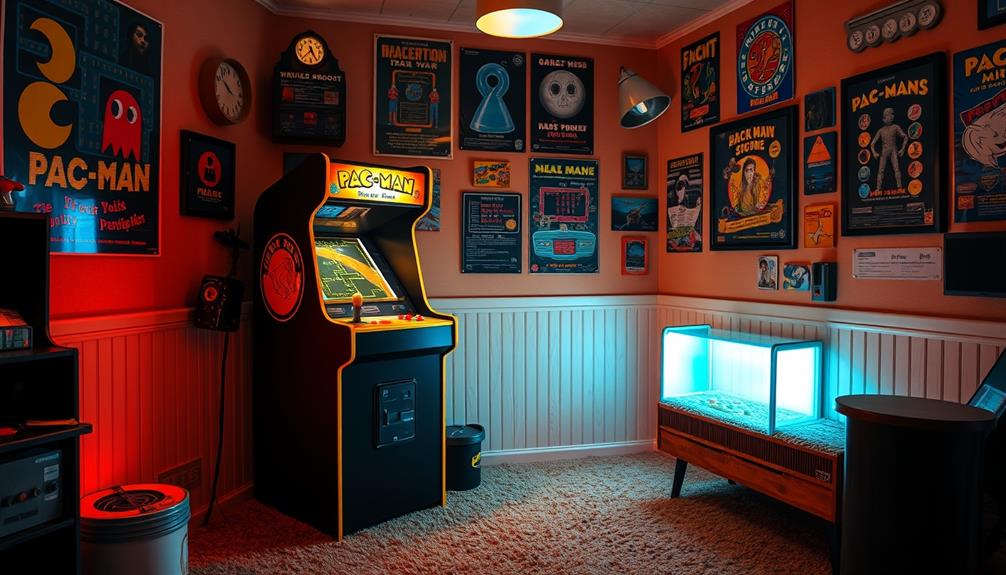The objective of pinball is to bring together skill, nostalgia, and community in an immersive experience. By mastering the flippers and timing, you aim to achieve high scores, while the vibrant lights and sounds keep you engaged. Each multiball session adds an element of chaos that makes it difficult to resist the pursuit of a new high score. The nostalgia evoked by vintage machines helps bridge the gap between generations by connecting to classic arcade memories. Additionally, the lively pinball community fosters friendly competition and collaboration. For those interested in learning more about how pinball has evolved and its cultural significance, continue to explore the captivating world of this beloved pastime.
Key Takeaways
- Pinball offers an engaging sensory experience through lights, sounds, and artwork, creating an immersive atmosphere for players.
- The pursuit of high scores fosters competition and skill development, enhancing player engagement and motivation.
- Unique game mechanics require precision and timing, making mastery of flipper control essential for successful gameplay.
- Pinball arcades create a vibrant community where players can connect, compete, and share strategies, fostering camaraderie.
- Nostalgia for classic arcade experiences and the artistry of machines contributes to pinball's cultural significance and enduring appeal.
Appeal and Experience of Pinball
When you step up to a pinball machine, you're not just playing a game; you're diving into a sensory experience that combines nostalgia, skill, and excitement. Each machine offers a unique tableau of lights, sounds, and artwork that draws you in.
The thrill of chasing a high score keeps your adrenaline pumping as you master the intricate mechanics of the game. With every flip of the flippers, you're not just aiming to keep the ball in play; you're engaging in a game of skill that demands focus and strategy. This blend of creativity and technical finesse mirrors the emphasis on creative expression and imagination in art, highlighting the limitless potential of artistic endeavors.
The multiball feature adds another layer of excitement, creating a chaotic yet exhilarating atmosphere as you juggle multiple balls, aiming for even greater challenges. This infinite replay value guarantees that no two sessions are ever the same, and you'll find yourself returning to discover new tactics and techniques.
Nostalgia plays an essential role, too; many players fondly remember their childhood experiences in arcades, forging a deep emotional connection to the game.
The intricate craftsmanship of pinball machines further enhances their appeal, transforming them into collectible treasures that celebrate the artistry of gaming culture.
Digital vs. Physical Pinball

The allure of pinball extends into two distinct domains: digital and physical. Each has its own appeal, and your preference might depend on what you value most in the pinball experience.
| Feature | Digital Pinball | Physical Machines |
|---|---|---|
| Accessibility | Widely available | Limited by location |
| Tactile Feedback | Lacks physical feel | Authentic sensations |
| Variety of Tables | Extensive library | Limited selection |
| Competitive Play | Online leaderboards | Local multiplayer only |
| Nostalgia | Modern graphics | Classic aesthetics |
Digital pinball games like Pinball Arcade and Pinball FX2 let you explore classic tables you might not find in their physical counterparts. They offer unique storytelling and mission modes that enhance gameplay. However, while digital pinball provides convenience and accessibility, it can't replicate the tactile feedback and immersive experience of physical machines. Many enthusiasts prefer the authentic sound and feel of real pinball, leading to a resurgence in home collections. Ultimately, whether you gravitate towards digital or physical pinball, both offer unique ways to engage with this beloved game.
Skill Development and Game Mechanics

Mastering pinball isn't just about luck; it requires honing specific skills that can dramatically enhance your gameplay. As you learn to play pinball, you'll discover that the mastery of flippers is essential for achieving high scores. Precise timing and control allow you to influence the ball's trajectory and hit targets effectively.
In a way, this mirrors the importance of nurturing an imaginative mindset found in design thinking, where creativity plays a pivotal role in problem-solving.
Skill development involves more than just random hits; it's about making deliberate shots. Advanced players use techniques like trapping and nudging to refine their gameplay. Understanding the mechanics and objectives of each table is vital, as each machine presents unique challenges and scoring opportunities.
To improve your skills and reach those coveted high scores, consider these key areas:
- Master flipper control for precise shots
- Learn to trap the ball to set up your next move
- Practice nudging to influence the ball's path
- Familiarize yourself with each table's unique mechanics
- Track your progress and aim to beat your high scores
While the ball's unpredictable movement might seem like luck, developing control and familiarity with table dynamics can greatly boost your overall success.
Community Engagement and Culture

When you step into a pinball arcade, you're not just playing a game; you're joining a vibrant community. The nostalgia tied to pinball machines often sparks conversations about shared experiences, creating bonds among players of all ages.
This sense of connection is akin to the way celebrity relationships evolve and inspire fandoms, as fans unite over their favorite stars and moments. As you connect with others over high scores and vintage designs, you'll see how this beloved pastime continues to shape cultural significance.
Social Connections in Pinball
Pinball isn't just about flipping flippers and racking up high scores; it's a vibrant community where enthusiasts come together to share their passion. The social connections you build while playing can enhance your experience, making it more than just a game.
You'll find that tournaments and events foster camaraderie, allowing players to compete for recognition while connecting over shared interests. Engaging in friendly competition can also lead to strategies to navigate partner shutdown in disputes, as players learn to communicate effectively and understand each other's perspectives.
Online platforms also play a significant role in this community, providing spaces for discussions on strategies, tips, and experiences that boost everyone's skills. You might even discover a niche in collecting themed pinball machines, sparking conversations about restoration projects and unique designs.
The arcade experience itself brings players together, where you can gather to share tips and enjoy the thrill of the game.
Here are a few aspects of social connections in pinball:
- Tournaments that build camaraderie
- Online forums for sharing strategies
- Collecting themed machines as a niche hobby
- Gathering in arcades for social play
- Cross-generational bonds through nostalgia
In every flip of the flipper, you're not just scoring points; you're forging friendships and memories.
Nostalgia and Cultural Significance
The sense of nostalgia surrounding pinball machines is palpable, especially for those who spent countless hours in arcades during the 1970s and 1980s. These iconic machines evoke memories of simpler times, drawing you back to moments spent with friends, competing for high scores, and engaging in spirited conversations about strategies.
The rise of venues like the Pinball Hall of Fame has only amplified this sense of community, showcasing the artistry and craftsmanship of vintage arcade games. Much like the enchanting atmosphere of Billy Gilmans Secret Wedding, pinball creates an inviting space where memories are made and shared.
Pinball's cultural significance is further underscored by its appearances in movies and TV shows, solidifying its status as a beloved form of entertainment. Collecting themed and vintage pinball machines has emerged as a niche hobby, allowing enthusiasts to preserve and celebrate the history of arcade games.
Barcade venues also play a vital role in revitalizing interest in pinball, creating spaces for both nostalgia and social interaction. They bridge the gap between generations, introducing younger players to the thrill of pinball while allowing older fans to relive cherished memories.
This blend of nostalgia and cultural significance makes pinball not just a game, but a shared experience that continues to resonate across the ages.
Historical Context of Pinball

Emerging from the early 1930s, pinball evolved from the tabletop game known as bagatelle, which can be traced back to the 1770s. The introduction of coin-operated machines transformed the landscape of entertainment, allowing players to enjoy pinball games in arcades and bars.
The first pinball machines used simple mechanics and metal balls, but they quickly gained popularity. Different cultural beliefs often intertwined with the game, enhancing its social appeal and connection among players, much like how astrology claims to influence personality traits and attractiveness.
However, pinball faced challenges due to legal restrictions and gambling perceptions, especially during the 1940s and 1950s when many cities in the U.S. banned the game. The industry saw a revival in the 1970s, fueled by technological advancements.
The release of the first solid-state pinball machine in 1977 signaled a significant shift, introducing electronic components that enhanced gameplay.
Key milestones in pinball history include:
- Evolution from bagatelle to coin-operated machines
- The rise of complex designs and features in the 1970s and 1980s
- Legal battles affecting public perception
- Resurgence of interest since the 2000s
- Modern machines featuring intricate narratives and designs
This rich history showcases pinball's resilience and adaptability, making it a beloved pastime across generations.
Gameplay Mechanics and Features

From its rich history, pinball has developed intricate gameplay mechanics and features that keep players engaged and challenged. You launch a ball into play using a plunger mechanism, aiming to hit various targets and ramps to score points throughout the game. As the ball moves around the playfield, players must use flippers to keep it in play and strategically aim for higher scoring opportunities. The pinball scoring system rewards players for accuracy and skill, with bonuses and multipliers adding to the excitement of the game. With each game offering unique challenges and objectives, pinball enthusiasts are constantly honing their skills and striving for higher scores.
Each pinball machine is uniquely designed with specific objectives that tie into its theme, encouraging you to complete missions for extra scoring opportunities. This aspect of gameplay mirrors the excitement found in family photoshoot fails, where unexpected moments add a layer of enjoyment.
One of the most exciting features is the multiball mode, where multiple balls can be in play at once, greatly increasing your scoring potential. This dynamic turns every moment into a thrilling challenge as you juggle several balls while trying to keep the ball from draining.
The tilt mechanism adds an essential layer of skill, detecting excessive movement of the machine and preventing cheating. You'll need to carefully manage your movements while maneuvering the ball's trajectory.
Scoring comes from hitting targets, maneuvering ramps, and completing challenges. As you aim to achieve high scores and secure a spot on the leaderboard, the combination of strategy and reflexes keeps you coming back for more.
Cultural Impact of Pinball

Pinball's cultural significance transcends mere entertainment, weaving itself into the fabric of popular culture over decades. As you engage with the flashing lights and sounds of the machine, you're not just playing a game; you're participating in a rich history that's influenced movies, TV shows, and music videos.
This cultural impact is evident in how pinball reflects the aesthetics of its era, making each machine a collectible piece of art. The resurgence of interest in pinball parallels the growing trend toward democratizing investment opportunities in various entertainment forms, highlighting the importance of accessible experiences.
Consider these aspects of pinball's cultural footprint:
- Featured prominently in films and television
- Artwork often mirrors the styles of different decades
- A thriving community of enthusiasts and tournaments
- Played in bars and arcades, fostering social interaction
- Vintage machines preserved for their historical significance
Since the 2000s, pinball has seen a resurgence, drawing players away from video games and back to the tactile joy of flippers and bumpers.
This revival not only celebrates the game's legacy but also enhances camaraderie among players, creating connections that span generations.
Evolution of Pinball Machines

As you explore the vibrant community surrounding pinball, it's fascinating to see how the machines themselves have evolved over the decades. The evolution of pinball machines began in the early 1930s with simple mechanical designs, but it took a giant leap forward when flippers were introduced in 1947. This innovation transformed gameplay into a skill-based experience where you could control the ball in play rather than relying solely on luck.
The holistic SEO approach to marketing can similarly enhance the visibility and appeal of pinball machines in today's digital landscape.
By the late 1970s, the first solid-state pinball machine emerged, incorporating electronic components that allowed for more complex gameplay, scoring systems, and features. This shift paved the way for iconic games like Medieval Madness, which showcased intricate themes and engaging mechanics that captured players' imaginations.
Despite a decline in the industry during the late 1990s due to the rise of video games, pinball has seen a resurgence in popularity, especially in home markets.
Modern machines now boast advanced technologies, including LCD screens for animations and online connectivity for score tracking. This ongoing evolution guarantees that pinball remains a dynamic and exciting form of entertainment, appealing to both new players and seasoned enthusiasts alike.
The Future of Pinball

Excitement surrounds the future of pinball, as new technologies and innovations promise to reshape the landscape of this beloved pastime.
You'll find that virtual pinball machines (vpins) are gaining traction, replacing traditional boards with immersive screens that attract a younger audience. Additionally, online modes are emerging, allowing you to compete for high scores in real-time, fostering a sense of community among players.
As the genre evolves, there's a growing interest in themed pinball experiences that reflect popular culture and music, enhancing the overall enjoyment of the game.
As you explore the future, consider the following developments:
- Hybrid experiences combining virtual reality and physical gameplay
- Increased demand for home pinball machines, driving prices up
- Enhanced community engagement through online leaderboards and events
- Continued appreciation for classic designs and vintage craftsmanship
- A growing market for innovative machines that blend tech with tradition
Despite these advancements, the charm of classic pinball designs remains strong.
You'll see that the craftsmanship of vintage machines continues to hold a special place in arcade culture.
The future certainly looks bright for pinball, merging the best of both worlds while keeping the nostalgic spirit alive.
Frequently Asked Questions
What Is the Main Goal of Pinball?
The main goal of pinball is to score points. You launch the ball, interact with targets, and complete missions unique to each machine, all while mastering techniques to maximize your score and enjoy the game. What is pinball lez about is the challenge of mastering the different features of each machine, such as ramps, bumpers, and flippers, to keep the ball in play as long as possible. It requires a combination of skill, timing, and strategy to truly excel at the game. So, ultimately, pinball is about having fun while constantly striving to improve your score and beat your own personal best.
Why Is Pinball Important?
Pinball's not just a game; it's a nostalgic journey. You'll experience a blend of skill and chance, engage in vibrant competitions, and connect with a community that celebrates both innovation and cherished memories.
What Is Pinball and Why Was It Illegal?
Pinball's a coin-operated game that combines skill and chance. It faced legal issues due to gambling associations, leading to its prohibition in some areas until flippers transformed it into a recognized entertainment form.
What Is the Science Behind the Pinball Game?
The science behind pinball involves physics principles, like mechanics and dynamics. You launch the ball, utilizing potential and kinetic energy, while steering angles and obstacles, balancing nudges, and triggering sensors for scoring.
Conclusion
In the end, pinball's like a dance between skill and chance, where each flip and tilt sparks joy. Remember that moment when you nailed a multiball and felt invincible? That rush encapsulates pinball's essence—it's about mastering the chaos, connecting with others, and enjoying the ride. As machines evolve, they'll keep inviting you back to the arcade floor, reminding you that life, much like a game of pinball, is all about embracing the unexpected.



